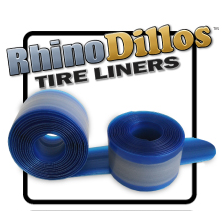Prevent Flats in Your Bike Tires - Best Method is RhinoDillos Tire Liners
Ppsssttt. Not another Flat! Since
the dawn of innertubes inside rubber tires, flat tires have been
dogging bicycle riders and stealing the fun. Inventors have come up with
many ways to stop these puncture flats. Here are the top 10 available
today.
Nothing steals the joy of a bike ride like a flat tire. And for most of the cyclists in the world there is a three strike rule. If you get three flat tires in a short period of time, you hang up the bike. The sad part of all this is that there are ways to prevent flats that are easy and inexpensive. One of the top experts on bicycle flats in the US is Randy Kirk, and he is flabbergasted that anyone ever gets a bicycle flat.
"There have been dozens of methods and products over the past 50 years or even longer that provide good protection against bicycle inner tube punctures. But the real breakthroughs came about 30 years ago. Today there are very high tech answers to flats, and yet riders continue to put up with the saddest sound in cycling…..psssffftt."
Here are the top ten ways to prevent flat tires, with number with number 1 being the best overall solution, taking into consideration effectiveness and cost.
1.
RhinoDillos Tire Liners - In 2011, a West Coast bicycle products
company brought a new tire liner to market. The big difference was an
improvement in the quality of the plastic. Using the dual durometer
approach, the company was able to significantly improve puncture
resistance while maintaining or even reducing the suggested retail for
dual durometer liners. With this product there really is no reason to
double up with other products.
2. Flat
resistant tires. Many tires today have extra rubber, added layers, or
other methods designed to provide resistance to thorns, stickers, rocks,
and other road and off road debris. This is a high cost solution, and
tires designed to be flat resistant are trading off other benefits such
as weight or comfort.
3. Combinations - Using a combination of
tire liners and either heavy duty tubes or tube sealants has been a
successful way to deal with the worst thorns in desert or tundra regions
of the US throughout the Western 10 states. This can be expensive and
very heavy, but not as heavy as the
airless inner tubes, and generally the ride is better, too.
airless inner tubes, and generally the ride is better, too.
4. Dual Durometer urethane tire liners (standard plastics) - By using two different plastics in tire
liners manufactures were able to improve the puncture resistance of the
side of the liner closest to the tire while making that portion next to
the tube softer and less likely to do damage to the tube. This
breakthrough became the standard until 2011. Inexpensive and very
effect. Light weight.
5. Single durometer urethane tire liners -
About 30 years ago, the plastic tire liner revolutionized flat tires due
to inner tube punctures. Today, such products are divided into
inexpensive liners where the plastic is all one type. These are more
likely than their more expensive brothers to get punctures and they are
also more likely to cause flats due to sharp edges. However, they are
very effective and low cost.
6.
Kevlar tire liners - These are very effective at preventing flats.
They are the most expensive solution and do have a rap for not lasting
very long. Some reviewers say that they disintegrate inside the tire
after a few years.
7. Inner tube sealants - The idea of this
product is that you have a liquid chemical in the inner tube that is
always on the ready to find any hole and fill it up. These products
have varying degrees of effectiveness, but are generally good at what
they do. There can be issues with valve stems being clogged and
removing the tube from a tire after a few leaks can be difficult.
8. Wrapping an old inner tube around the
new one - Some folks do a DIY method of flat prevention. They cut open
an old inner tube and wrap it around the new one. This is more
effective than a heavy duty tube, but not by much. The cost is perfect.
Only your time.
9. Airless Innertubes - The most
popular of these is a very thick rubber hose that gets the needed
rigidity from the thickness of the tube, rather than air pressure. They
are fairly expensive, very heavy, and for any but the shortest ride are
very sluggish riding.
10. Heavy duty inner tubes. These are
merely inner tubes that are extra thick. They do provide some benefit,
but the trade off in weight is only worth it in the special case seen in
#2 which follows below.
So, don't take a chance on ruining your day with a flat. The bicycle industry has plenty of great approaches that can save you embarrassment, time, and stress.
So, don't take a chance on ruining your day with a flat. The bicycle industry has plenty of great approaches that can save you embarrassment, time, and stress.




No comments:
Post a Comment